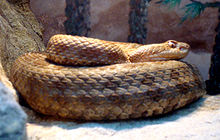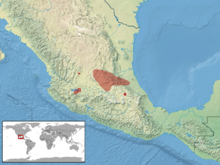| Crotalus aquilus | |
|---|---|

| |
| Conservation status | |
 Least Concern (IUCN 3.1) | |
| Scientific classification | |
| Domain: | Eukaryota |
| Kingdom: | Animalia |
| Phylum: | Chordata |
| Class: | Reptilia |
| Order: | Squamata |
| Suborder: | Serpentes |
| Family: | Viperidae |
| Genus: | Crotalus |
| Species: | C. aquilus |
| Binomial name | |
| Crotalus aquilus Klauber, 1952 | |

| |
| Synonyms | |
| |
Crotalus aquilus, known as the Querétaro dusky rattlesnake or Queretaran dusky rattlesnake, is a pit viper species found in the highlands of central Mexico. Like all other pit vipers, it is venomous. No subspecies are currently recognized. The specific name, aquilus, is Latin for "eagle" and refers to the high altitude at which this species is found.
Description
This species grows to a maximum reported total length of 67.8 cm (26.7 in), but most adult specimens, which have been described as heavy-bodied, are less than 50 cm (20 in) long.
Geographic range
They are found in the highlands of central Mexico in Guanajuato, Hidalgo, México, Michoacán, and San Luis Potosí. The type locality given is "near Alvarez, San Luis Potosí, Mexico".
Habitat
These snakes are found in the open grassy and generally rocky habitats north of the Trans-Mexican Volcanic Belt. They also occur in pine-oak forest, open karstic areas, grassy mountain meadows, and stony mesquite-grassland.
Conservation status
This species is classified as Least Concern on the IUCN Red List (v3.1, 2001). Species are listed as such due to their wide distribution, presumed large population, or because they are unlikely to be declining fast enough to qualify for listing in a more threatened category. The population trend was down when assessed in 2007.
References
- ^ Mendoza-Quijano, F.; Quintero Díaz, G. (2007). "Crotalus aquilus". IUCN Red List of Threatened Species. 2007: e.T64310A12763161. doi:10.2305/IUCN.UK.2007.RLTS.T64310A12763161.en. Retrieved 11 June 2024.
- ^ Campbell, J.A.; Lamar W.W. (2004). The Venomous Reptiles of the Western Hemisphere. Ithaca and London: Comstock Publishing Associates. pp. 870 pp. 1500 plates. ISBN 0-8014-4141-2..
- Klauber, L.M. (1997). Rattlesnakes: Their Habitats, Life Histories, and Influence on Mankind. Second Edition. First published in 1956, 1972. Berkeley: University of California Press. pp. 870 pp. 1500 plates. ISBN 0-520-21056-5.
- "Crotalus aquilus". Integrated Taxonomic Information System. Retrieved 9 July 2007.
- 2001 Categories & Criteria (version 3.1) at the IUCN Red List. Accessed 13 September 2007.
Further reading
- Klauber, L.M. 1952. Taxonomic studies on rattlesnakes of Mainland Mexico. Bull. Zool. Soc. San Diego 26: 1–143.
| Taxon identifiers | |
|---|---|
| Crotalus aquilus | |